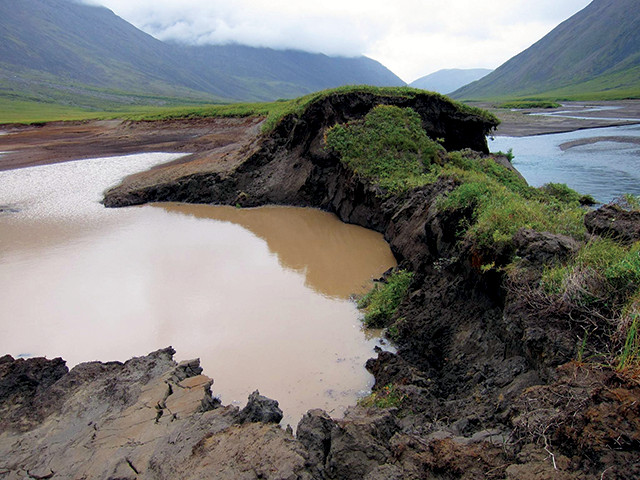
by Timothy Oleson Tuesday, April 10, 2018

Researchers studying soil cores from Alaska estimate that soils in Northern Hemisphere permafrost regions contain far more mercury than all other soils around the world combined. Credit: National Park Service/C. Ciancibelli.
From Antarctica to the Arctic; from polar caps, permafrost and glaciers to ocean-rafted sea ice; and from burly bears to cold-loving microbes, fascinating science is found in every nook and crevasse of Earth’s cryosphere, and new findings are announced often. Here are a few of the latest updates.
Scientists studying deposition of atmospheric pollutants onto the Greenland Ice Sheet over the last six decades have found that, while sulfate levels preserved in the ice correspond with anthropogenic emissions trends, nitrate levels do not. In 2015, Yoshinori Iizuka of Hokkaido University in Japan and colleagues collected a 90-meter-long ice core from the Southeastern Greenland Dome that dates back to 1957. After accounting for contributions from major volcanic eruptions, like Pinatubo in 1991, they found that sulfate levels have steadily decreased since the 1980s, in line with reduced emissions from North America — thought to be the main contributor to aerosol deposition in Greenland — as well as from Europe and Russia. Despite a similar trend of reduced airborne nitrate emissions, however, the team found that nitrate levels observed in the ice core rose through the 1970s and ‘80s, peaked in the early ‘90s, and have since remained elevated relative to 1960s–1980s levels, when emissions were higher than today. The cause of the nitrate discrepancy is not clear yet, the researchers wrote in the Journal of Geophysical Research: Atmospheres. They suggested that increased deposition from North American forest fires may have been the main factor in the 1990s peak, and that changes in atmospheric chemistry — possibly related to increased amounts of dust and sea salt in the air — could be contributing to longer residence times for, and delayed deposition of, nitrate in the atmosphere, thus prolonging the elevated concentrations seen in the ice record.
Increased snowfall over parts of Antarctica, resulting from warming air holding more moisture, may partially or fully offset the loss of Antarctic ice from melting, thus mitigating the continent’s contribution to sea-level rise. But few observations are available to assess this potential mitigation and test climate model projections. In new research, scientists who studied a 165-meter-long ice core that records annual precipitation over the past 2,000 years in western Queen Maud Land (QML) in East Antarctica, reported that, in recent decades, the region has received 25 percent more snow compared to the pre-industrial average, while also warming significantly. Thus, large snowfalls there in recent years thought to be anomalous are actually part of a longer-term trend, wrote Brooke Medley of NASA’s Goddard Space Flight Center in Greenbelt, Md., and colleagues in Geophysical Research Letters. Based on their observations from the ice core and from temperature data, they found that some climate model projections for snowfall and temperature increases in QML are too low, suggesting the models may underestimate the potential of increased precipitation in QML to counteract sea-level rise. The researchers noted that more records of snowfall and temperature from across the continent are needed to assess whether the trend seen in QML holds for other parts of Antarctica.
Soils in Northern Hemisphere permafrost regions hold roughly twice as much mercury as the combined total of all other soils around the world, the ocean, atmosphere and vegetation, according to a new study in Geophysical Research Letters that offers the first comprehensive assessment of soil-bound mercury in the far north. Mercury can be toxic to animals, including humans, so elevated levels in the environment pose hazards for natural ecosystems and public health. Paul Schuster of the U.S. Geological Survey’s National Research Program in Boulder, Colo., and colleagues measured mercury concentrations in soil cores from 13 sites in Alaska’s interior and North Slope. At each site, they drilled through the active layer — which freezes and thaws annually, and is where mercury that settles out of the atmosphere binds to soil organic matter and is eventually buried — and into the permafrost below. Combining their results with previously published measurements from other locations as well as maps of soil carbon — a proxy for soil organic matter and mercury content — they estimated the total mercury content of northern permafrost region soils to be about 1,650 gigatons, nearly 800 gigatons of which is sequestered in permafrost. “There would be no environmental problem if everything remained frozen, but we know Earth is getting warmer,” Schuster said in a statement. “Thawing permafrost provides a potential for mercury to be released.”
© 2008-2021. All rights reserved. Any copying, redistribution or retransmission of any of the contents of this service without the expressed written permission of the American Geosciences Institute is expressly prohibited. Click here for all copyright requests.